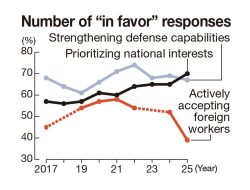12:44 JST, December 7, 2020
A small probe that had been traveling through outer space approached Earth after six years. It is a significant achievement that Japan can be proud of.
A capsule from the Japan Aerospace Exploration Agency (JAXA)’s Hayabusa2 unmanned probe landed in the Australian desert. It is believed to contain stones and sand from the asteroid Ryugu. It is a remarkable accomplishment that follows the achievements of the first Hayabusa in 2010.
Now that it has been retrieved, the capsule will be sent to Japan for analysis of the samples contained inside. It will reveal something of the nature of asteroids and is expected to help trace the formation of the solar system. It is hoped that Japan will share the samples with other countries and make great use of them in future scientific research.
After collecting samples from the surface of the asteroid in its first landing, the probe landed a second time near a crater it created by shooting a copper projectile against the surface. It is valuable that samples from the asteroid’s interior were collected. The success of this task is a testament to Japan’s excellent technological capabilities.
As it was believed that samples had been secured in the first landing, the view of some within JAXA was that there would be no need to force a second landing. The team deserves admiration for its commitment to not losing its positive attitude and calmly analyzing the situation before attempting the second landing.
The conditions were never favorable. Contrary to expectations, the surface of Ryugu was rocky with few plains available for the probe to land on safely. The JAXA team located a place with few rocks and landed the probe accurately.
The first Hayabusa’s return to Earth was precarious, as there was a failure in its main engine, among other troubles. With damage all over its body, the spacecraft struck a chord with many people, setting off a boom that resulted in a movie production based on the mission. However, it is said that many technical problems are left to be resolved.
Based on this lesson, the team took all possible measures to prepare for the Hayabusa2 mission, and it experienced almost no trouble as a result. In contrast to the first Hayabusa, which burned up on reentry into the atmosphere, this probe set out to explore another asteroid with its remaining fuel after it ejected the capsule.
In October, the U.S. National Aeronautics and Space Administration, which leads the world in the field of space, made a U.S. version of Hayabusa land on the asteroid Bennu, following in the footsteps of Japan. China, which aims to become a “space power,” also had its Chang’e-5 probe land on the moon this month for a mission to collect soil samples.
Space development has entered a new era that incorporates the help of private companies. In the future when each country aims to develop resources as a result of exploring the lunar surface, high-precision landing technologies may be required to target specific locations that have a high availability of resources.
Japan must continue with its unmanned spacecraft probes to further improve the technologies that it has built up and nurture the next generation.
"Editorial & Columns" POPULAR ARTICLE
-

Corporate Interim Earnings: Companies Must Devise Ways to Overcome Trump Tariffs
-

Violations of Subcontract Law: Major Automakers Must Eliminate Old Practices
-

Local Governments’ Tax Revenues: Devise Ways to Correct Imbalances in Tax Sources
-

Takaichi’s Summit with Economics-Minded Trump Successfully Advanced Japan’s Security Interests
-

Lower House Budget Committee: Unrestrained Fiscal Stimulus Is Unacceptable
JN ACCESS RANKING
-

Govt Plans to Urge Municipalities to Help Residents Cope with Rising Prices
-

Japan Resumes Scallop Exports to China
-

Japan Prime Minister Takaichi Vows to Have Country Exit Deflation, Closely Monitor Economic Indicators
-

Japan to Charge Foreigners More for Residence Permits, Looking to Align with Western Countries
-

JR East Suica’s Penguin to Retire at End of FY2026; Baton to be Passed to New Character



















